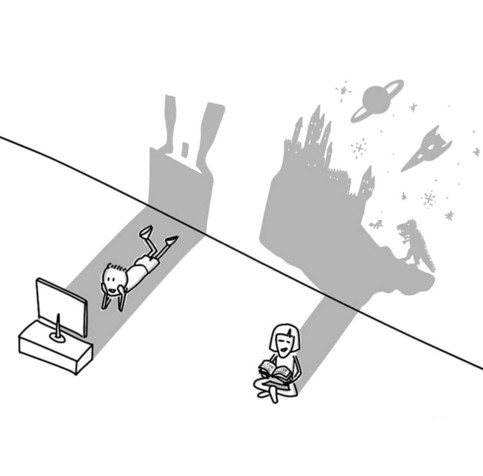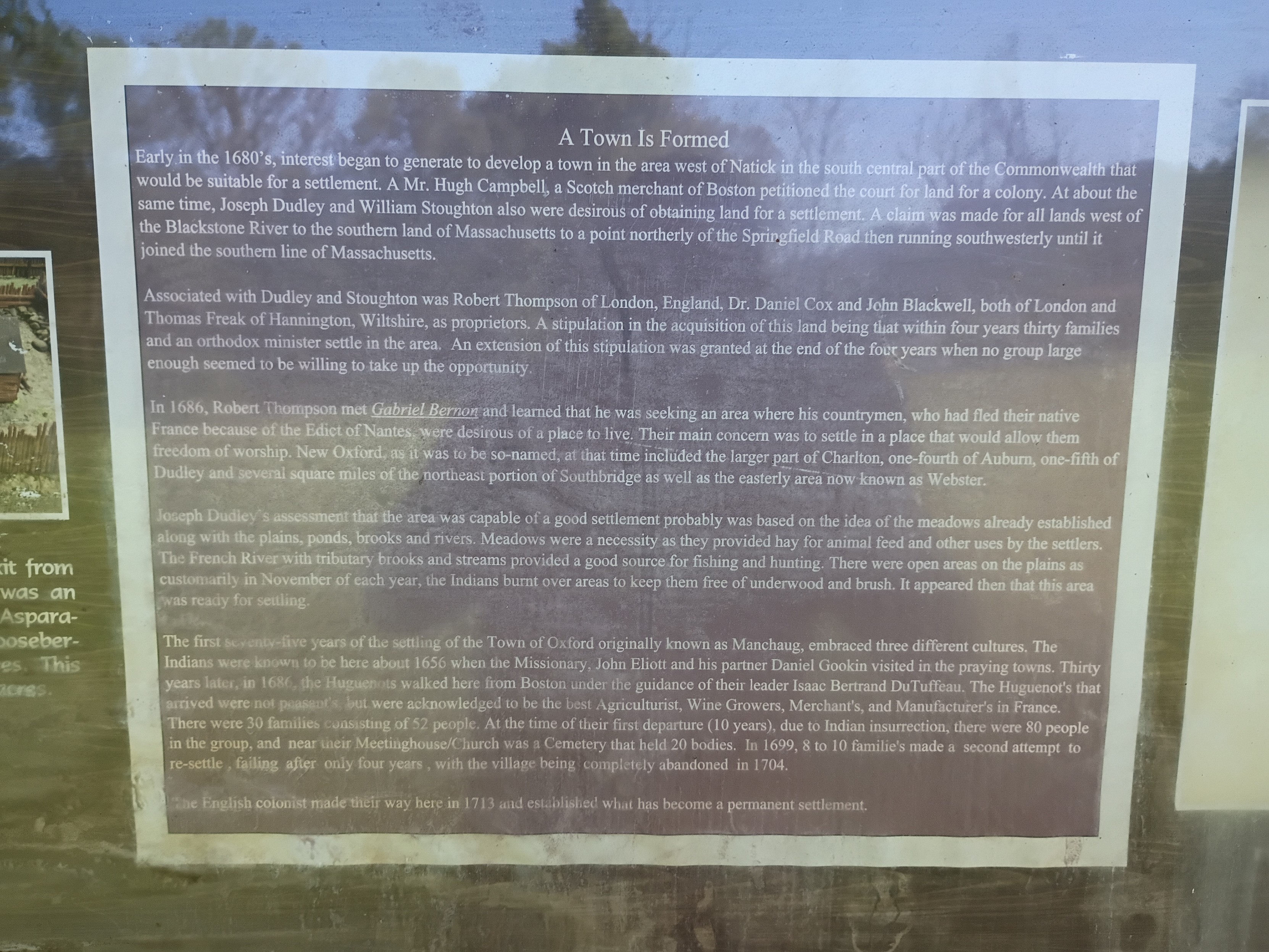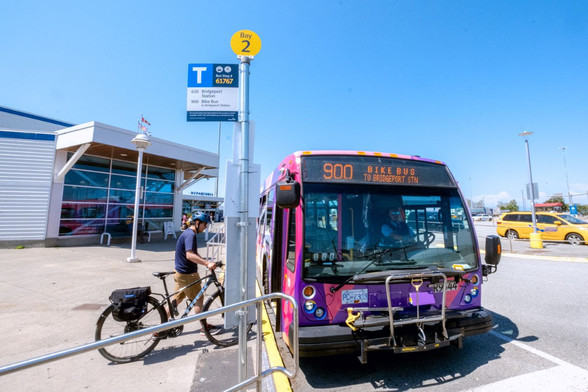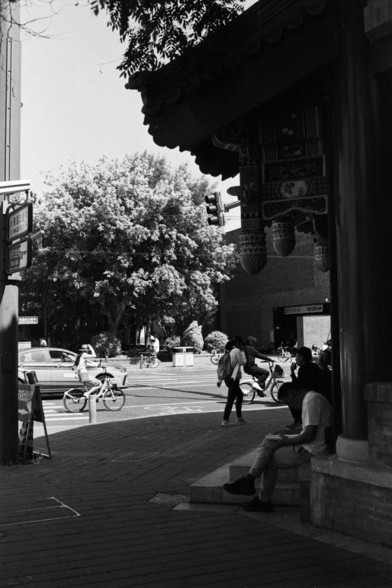2025-07-16 00:07:28
o.O
#IYKYK
2025-07-04 20:14:31
Long; central Massachusetts colonial history
Today on a whim I visited a site in Massachusetts marked as "Huguenot Fort Ruins" on OpenStreetMaps. I drove out with my 4-year-old through increasingly rural central Massachusetts forests & fields to end up on a narrow street near the top of a hill beside a small field. The neighboring houses had huge lawns, some with tractors.
Appropriately for this day and this moment in history, the history of the site turns out to be a microcosm of America. Across the field beyond a cross-shaped stone memorial stood an info board with a few diagrams and some text. The text of the main sign (including typos/misspellings) read:
"""
Town Is Formed
Early in the 1680's, interest began to generate to develop a town in the area west of Natick in the south central part of the Commonwealth that would be suitable for a settlement. A Mr. Hugh Campbell, a Scotch merchant of Boston petitioned the court for land for a colony. At about the same time, Joseph Dudley and William Stoughton also were desirous of obtaining land for a settlement. A claim was made for all lands west of the Blackstone River to the southern land of Massachusetts to a point northerly of the Springfield Road then running southwesterly until it joined the southern line of Massachusetts.
Associated with Dudley and Stoughton was Robert Thompson of London, England, Dr. Daniel Cox and John Blackwell, both of London and Thomas Freak of Hannington, Wiltshire, as proprietors. A stipulation in the acquisition of this land being that within four years thirty families and an orthodox minister settle in the area. An extension of this stipulation was granted at the end of the four years when no group large enough seemed to be willing to take up the opportunity.
In 1686, Robert Thompson met Gabriel Bernor and learned that he was seeking an area where his countrymen, who had fled their native France because of the Edict of Nantes, were desirous of a place to live. Their main concern was to settle in a place that would allow them freedom of worship. New Oxford, as it was the so-named, at that time included the larger part of Charlton, one-fourth of Auburn, one-fifth of Dudley and several square miles of the northeast portion of Southbridge as well as the easterly ares now known as Webster.
Joseph Dudley's assessment that the area was capable of a good settlement probably was based on the idea of the meadows already established along with the plains, ponds, brooks and rivers. Meadows were a necessity as they provided hay for animal feed and other uses by the settlers. The French River tributary books and streams provided a good source for fishing and hunting. There were open areas on the plains as customarily in November of each year, the Indians burnt over areas to keep them free of underwood and brush. It appeared then that this area was ready for settling.
The first seventy-five years of the settling of the Town of Oxford originally known as Manchaug, embraced three different cultures. The Indians were known to be here about 1656 when the Missionary, John Eliott and his partner Daniel Gookin visited in the praying towns. Thirty years later, in 1686, the Huguenots walked here from Boston under the guidance of their leader Isaac Bertrand DuTuffeau. The Huguenot's that arrived were not peasants, but were acknowledged to be the best Agriculturist, Wine Growers, Merchant's, and Manufacter's in France. There were 30 families consisting of 52 people. At the time of their first departure (10 years), due to Indian insurrection, there were 80 people in the group, and near their Meetinghouse/Church was a Cemetery that held 20 bodies. In 1699, 8 to 10 familie's made a second attempt to re-settle, failing after only four years, with the village being completely abandoned in 1704.
The English colonist made their way here in 1713 and established what has become a permanent settlement.
"""
All that was left of the fort was a crumbling stone wall that would have been the base of a higher wooden wall according to a picture of a model (I didn't think to get a shot of that myself). Only trees and brush remain where the multi-story main wooden building was.
This story has so many echoes in the present:
- The rich colonialists from Boston & London agree to settle the land, buying/taking land "rights" from the colonial British court that claimed jurisdiction without actually having control of the land. Whether the sponsors ever actually visited the land themselves I don't know. They surely profited somehow, whether from selling on the land rights later or collecting taxes/rent or whatever, by they needed poor laborers to actually do the work of developing the land (& driving out the original inhabitants, who had no say in the machinations of the Boston court).
- The land deal was on condition that there capital-holders who stood to profit would find settlers to actually do the work of colonizing. The British crown wanted more territory to be controlled in practice not just in theory, but they weren't going to be the ones to do the hard work.
- The capital-holders actually failed to find enough poor suckers to do their dirty work for 4 years, until the Huguenots, fleeing religious persecution in France, were desperate enough to accept their terms.
- Of course, the land was only so ripe for settlement because of careful tending over centuries by the natives who were eventually driven off, and whose land management practices are abandoned today. Given the mention of praying towns (& dates), this was after King Phillip's war, which resulted in at least some forced resettlement of native tribes around the area, but the descendants of those "Indians" mentioned in this sign are still around. For example, this is the site of one local band of Nipmuck, whose namesake lake is about 5 miles south of the fort site: #LandBack.
2025-06-16 09:10:20
Linear-quadratic stochastic nonzero-sum differential games between graphon teams
De-xuan Xu, Zhun Gou, Nan-jing Huang
https://arxiv.org/abs/2506.11468 http…
2025-06-16 07:42:19
Black-Box Edge AI Model Selection with Conformal Latency and Accuracy Guarantees
Anders E. Kal{\o}r, Tomoaki Ohtsuki
https://arxiv.org/abs/2506.11391 https…
2025-06-14 22:21:31
Does the fuckwit know he's contradicting himself?
"We've already been moving assets to the region, including jets, and that is for contingency support across the region," he told reporters.
"Our constant message is de-escalate, and therefore everything we're doing, all discussions we're having are to do with de-escalation."
UK sends more RAF jets to Middle East as PM urges de-escalation - BBC News
2025-07-08 14:14:40
A research paper published by the US Department of Agriculture (USDA), though not yet peer-reviewed,
has found nearly all bee colonies suffering collapse had contracted a bee virus spread by
parasitic mites that appear to have developed resistance to the main chemicals used to control them.
Varroa mites
– equivalent in size to a dinner plate on a human body
– crawl and jump between worker bees.
If there are no infections present, they do not typically dama…
2025-06-09 17:41:56
From Translink
Bike Bus returns with Summer Service Changes
Seasonal service increasing on 13 routes to popular outdoor destinations
TransLink’s popular Bike Bus is back for summer service starting Friday, June 27 as part of upcoming service changes across the region.
TransLink’s 900 Bike Bus service also returns for cyclists between Bridgeport Station and Tsawwassen Ferry Terminal. These retrofitted buses have eight interior bicycle racks and follow Route 620.
2025-06-13 05:48:41
2025-07-07 00:30:06
Urban Solitude II 🈳
城市孤独 II 🈳
📷 Pentax MX
🎞️Fujifilm Neopan SS, expired 1995
buy me ☕️ ?/请我喝杯☕️?
#filmphotography
2025-06-29 12:37:01
A while ago the media reported that most of the long-distance "suburban" trains between #Wrocław and #Poznań will be discontinued, and instead one will have to change trains midway. Irrespective of whether it's actually going to happen, let's consider it.
As you can probably tell by now, I'm not a stranger to changing trains. In fact, there are some direct connections that I do criticize. For example:
• Poznań — Szczecin — Świnoujście, where arriving at Szczecin Główny and turning back to leave the city is a waste of time. It's better to change trains at Szczecin Dąbie.
• Poznań — Krzyż — Kostrzyn, where instead of using a single railbus, you can use a larger EMU for the Poznań — Krzyż segment, and a smaller DMU for Krzyż — Kostrzyn (in fact, only recently the "direct" Poznań — Kostrzyn train involved just that, but it was supposed to be temporary).
However, good matches are the key. Say:
1. Max 10 minutes (when there are no delays) from one train to the other.
2. "Door-to-door" transfer — without having to carry all your luggage across platforms.
3. Reliable connection — if one train is delayed, the other train waits for it (or there are so many alternatives that it doesn't have to).
Can such a thing happen on Poznań — Wrocław route? I have my doubts.
I've been using these trains for years, and I can say this: there is no effort to match train from/to Poznań with other trains in Wrocław. Sometimes the trains depart 10 minutes before the first train from Poznań arrives, sometimes I need to transfer in 10 minutes, and sometimes I have to wait over an hour. And the same in the other direction.
Perhaps things would actually improve if the route is split. Perhaps people would actually care. Maybe even the trains would be fitted better to the timetable in Wrocław. But I find it hard to believe.
EDIT: One final thought — since there is no real reason to split these connections (except for profiteering), why make travellers' lives harder?
#rail










